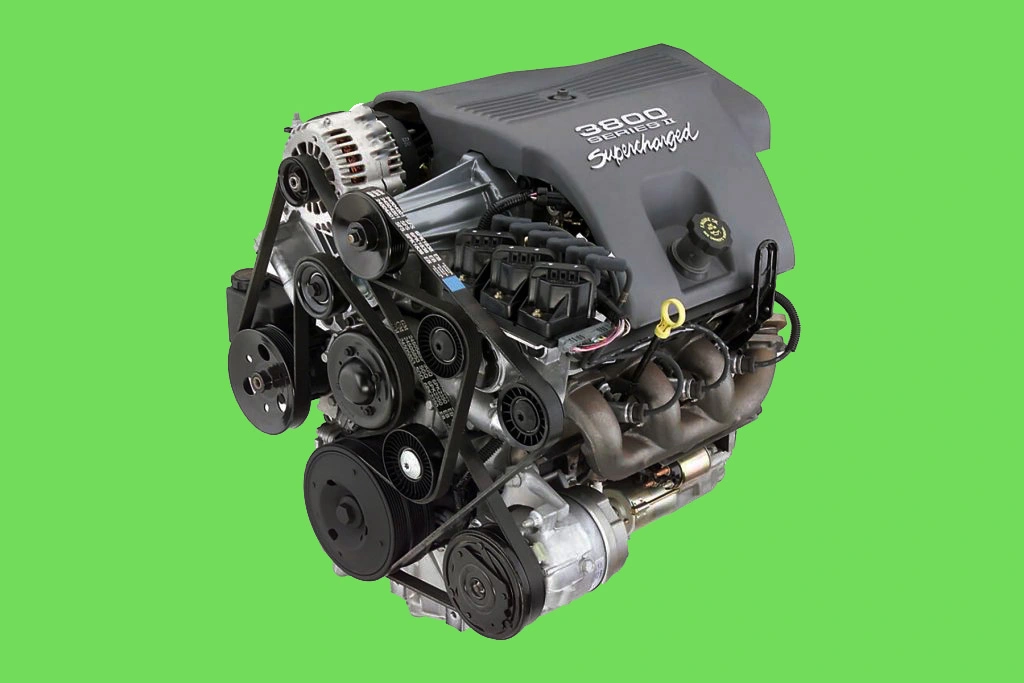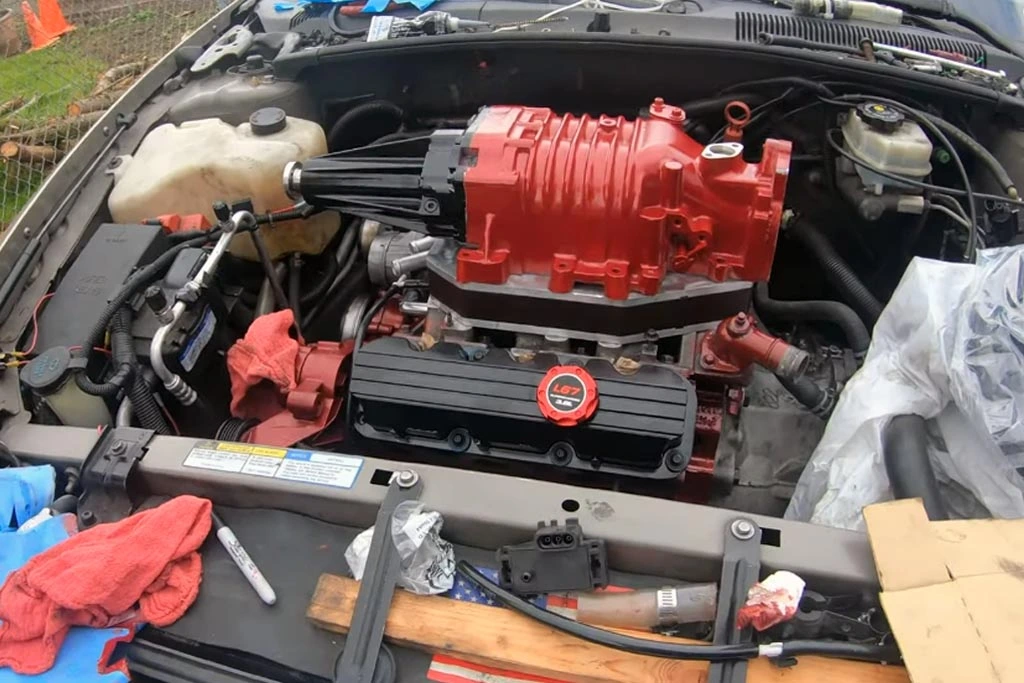In the 3800 series 2, an intermittent chuggle or hesitation felt during simple acceleration or while cruising at highway speeds without Check Engine light or fault codes set could be caused by the automatic transmission torque converter clutch operating intermittently (TCC). The issue is not with the torque converter clutch or clutch solenoid but with a faulty signal from the engine’s throttle position (TP) sensor to the powertrain control module computer. The TPS sensor must be replaced to resolve this issue.
In this article, we will discuss about 3800 series 2 common problems. After reading this article, you will find out everything you need to know about the 3800 series 02. So welcome to ItIsMyCar.
What is the 3800 series 2 engine?
The GM 3800 Series II engine, which was introduced in 1995, differs significantly from its predecessor, the Series I engine. While the 3.8L engine’s stroke remained 3.4″ (86 mm) and bore remained 3.8″ (97 mm), the engine architecture changed dramatically.
The deck height is lower than that of the Series I, reducing weight and total engine package size. To make this change, GM engineers needed to shorten the piston connecting rods by 1″ (25 mm) and redesign the crankshaft.
A redesigned cylinder head featured bigger valves and a higher compression ratio, while a new intake manifold improved breathing. The end result was a more fuel-efficient 205 hp and 230 lb.-ft. Powerplant.

What GM cars have a 3800 series 2 engine?
- The Oldsmobile Intrigue line was produced from 1994 to 1999.
- The Pontiac Grand Prix 997-2003 was held in December 1999.
- The Buick Regal was produced from 1997 to 2003.
- The Chevrolet Impala was produced from 2000 to 2003.
- Chevrolet Lumina, available from 998 to 1999.
- Model number 998-2003 Monte Carlo.
What Are GMC Vehicles Equipped with the 3800 Supercharged Engine?
Similarly, supercharged three-six cylinder engines are available in a variety of Chevrolet, Buick, and other General Motors models, including, but not limited to, the 1996-2005 Buick Park Avenue Ultra, the 199712-2004 Buick Regal GS, and a variety of Buick Riviera sedans and coupes.
3800 series 2 supercharged engine specs.
The L67 is a supercharged version of the 3800 Series II L36 that debuted in 1996, a year after the naturally aspirated version. It employs the Eaton Generation III M90 supercharger, which has a 3.8 in (97 mm) pulley, a larger throttle body, different fuel injectors, cylinder heads, and lower intake manifold and pistons than the L36.
The engine blocks are the same in both engines, but the compression is reduced from 9.4:1 in the L36 to 8.5:1 in the L67. The engine produced 240 hp (180 kW) and 280 lb-ft (380 Nm) of torque, according to GM.

In most applications, final drive ratios are reduced to improve fuel economy and make better use of the engine’s torque at low RPMs. The engine, like most 3800 V6s, is well known for its dependability and low maintenance costs.
Because of its strong internals and impressive power gains from basic upgrades, the engine is a popular choice for aftermarket modification. The engine was built in Flint, Michigan, and it received LEV certification in 2001.
3800 series 2 common engine problems.
Engine cracking without starting.
There can be a variety of causes for no start, but the most common in the Buick-3800 engine is faulty CKP sensors and ICM. In this case, CKP stands for the crankshaft position, and ICM stands for the ignition control module.
Diagnosis.
To begin, the CK or crank sensor can be diagnosed by inspecting the engine wiring diagram in your vehicle. To find the fault, you must first test the voltages of the circuits for the ignition module and many crank sensors. Furthermore, when you turn the key on, 4-8 volts must be found between each crank sensor. If it fails the tests, replace the crank sensors.
The coolant in the intake manifold is leaking.
Coolant leaks in Buick-3800 engines, particularly in Series II 3800 engines. Similarly, its massive plastic consumption has caused problems for people.
Diagnostic.
If it runs in an area where the cylinder head gets sealed coolant passage due to the manifold, the OEM gasket manifold intake tends to weaken after 60,000 miles.
Intermittent hesitancy or chugging
During highway cruising or light acceleration, you may notice an intermittent hesitation or chuggle. It occurs when the automatic TCC’s (transmission torque converter) intermittent operations do not set fault codes or when the check engine light does not illuminate.
Diagnostic
This is not because of a problem with the clutch solenoid or the torque converter clutch. However, the faulty input is the sole cause of this issue in engine-3800. The engine’s TPS (throttle position sensor) sends incorrect data to the PCM computer (powertrain control module computer).
This issue in engine-3800, however, can be resolved by replacing the throttle position sensor (TPS).
Intermittent misfire while driving.
It happens while driving due to a worn spark plug or a weak coil.
Diagnostic
When an intermittent misfire occurs while driving, first remove the spark plugs and inspect them. There must be a 0.60-inch gap between these spark plugs. If your spark plug is fine, leave it alone and proceed to inspect the ignition wires.
Wires with a mileage of 100,000 miles or more can produce high resistance. Furthermore, this resistance may cause a misfire in your engine. Replace any such wires, damaged wires, loosely fitted wires, or cracked wires in your engine. However, if your wires and plugs are in good condition, you should not replace them.
However, if your engine continues to behave in the same manner after replacing the damaged wires and plugs, use a scanning tool to look for misfire codes. Furthermore, keep the check engine light on and make sure you get 1-2 misfire codes for the cylinders that are causing misfires.
Furthermore, the last digit of any misfire code indicates the cylinder number. Take, for example, a cylinder with code P0302; the 2 in this code indicates that the number cylinder is misfiring.
Some related FAQs about 3800 Series 2 Common Problems
What is the distinction between the 3800 Series 2 and the 3800 Series 3?
The main difference between the motors is that the Series III has stronger connecting rods, and an aluminum upper plenum, which eliminates the leak point of the Series II, and a return-less fuel system configuration.
Why did GM discontinue production of the 3800?
Because GM couldn’t get consistent quality from the difficult-to-cast aluminum blocks, the engine was discontinued after only two years. However, the basic design and technology were revived for an iron block, a 198-cubic-inch V6 engine.
We hope you’ve got the answer that you’ve needed for the question, “3800 Series 2 Common Problems” reading our explanation. If you have more questions just leave a comment below, and we are really straightforward to help you further. If you need review and problems of the Reset GMC Acadia AC, check this link for it. Thank you.
